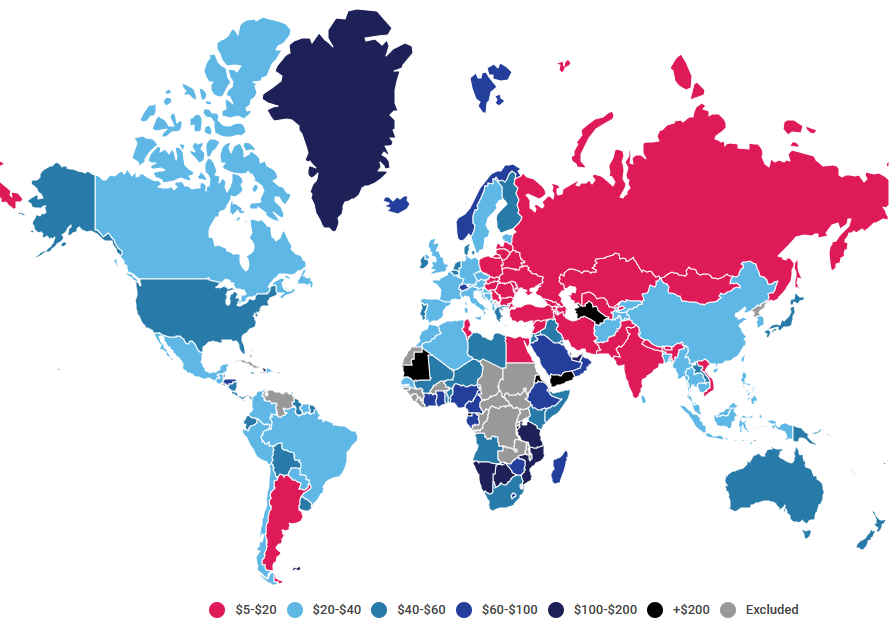118 Countries Have Cheaper Broadband Internet Than the US Right Now
However, the average subscription in the U.S. is $17.69 cheaper than last year.

UK-based broadband comparison website Cable.co.uk has published its annual global broadband pricing information and put the U.S. in the 119th spot in terms of pricing for consumer Internet access, as spotted by TechSpot. Last year, the U.S. didn't fare much better and ranked 104th.
That's not to say that prices for broadband in the U.S. are going up. Rather, the year-on-year cost has dropped by $17.69 for the average subscription. But that hasn't done much to help the position in the global rankings, since prices for broadband have been falling all over the world.
The cable comparison site noted that global broadband speeds increased by 20.65% on average between 2018 and 2019. Meanwhile, the average price of a broadband package decreased by 19.975% between the end of 2018 and beginning of 2020, it said.
Despite the almost abysmal rankings for pricing on the global scale, the U.S. fares quite well when it comes to broadband speeds. In 2017, the average connection in the U.S. had a speed of 20 Mbps. In 2018 that figure rose to 25.86 Mbps, and in 2019 it jumped to 32.89 Mbps. Consequently, the U.S. is in 15th place when it comes to average broadband speed connections.
Leading the connection speed charts is Taiwan with an average connection speed of 85.02 Mbps, and Yemen takes last place at a meager 0.38 Mbps.
Back to prices. The most expensive country is Eritrea, where the average cost of fixed-line broadband is a painful $2,666.24 per month. Yemen followed closely at $2,466.67, and the third most expensive location was Mauritania with an average cost of $694.63. Note that in many parts of the world, large portions of the population don't use broadband, and less developed countries often rely on mobile data connections rather than fixed-line connections for Internet access.
If you want the cheapest fixed-line Internet access, you'll have to move to Syria, where the average broadband connection costs just $6.60 a month.
Get Tom's Hardware's best news and in-depth reviews, straight to your inbox.
Niels Broekhuijsen is a Contributing Writer for Tom's Hardware US. He reviews cases, water cooling and pc builds.
-
Dantte This is extremely misleading!Reply
A lot of those countries with lower cost are very small and have very low amounts and easy to implement infrastructure to support their broadband. And others like SYRIA, broadband may be the cheapest, but access to such services is virtually non-existent, so of course its cheap, $0 have been invested in infrastructure there.
You want avg speeds in the US to equal Taiwan (85Mbps)... how many TRILLIONS do you have to invest in the infrastructure to support such a system nation wide?
A fair and accurate article would compare the US prices and speeds against countries with similar sized (sq-mileage), similar population, and similar access to services. Bottom line, there are 3 major variables not accounted for in this article! -
Giroro "Despite the almost abysmal rankings for pricing on the global scale, the U.S. fares quite well when it comes to broadband speeds. In 2017, the average connection in the U.S. had a speed of 20 Mbps. In 2018 that figure rose to 25.86 Mbps, and in 2019 it jumped to 32.89 Mbps. "Reply
What is the definition/minimum speed of broadband in this context? I think the FCC started using 25/3 Mbps back in 2015. Has is it increased since then, or based on our current FCC, lowered? Or at least how does the UK research define it?
Dantte said:You want avg speeds in the US to equal Taiwan (85Mbps)... how many TRILLIONS do you have to invest in the infrastructure to support such a system nation wide?
The answer is "literally no amount of money can upgrade our internet infrastructure". Because right now it isn't a funding problem its a legislation/monopoly problem. It is nearly impossible to get permits to lay fiber on public lands - and it is essentially illegal for competition to enter the market in many municipalities.
Not that the cost would matter - Internet is not a public utility, so it isn't "our" infrastructure at all.
For what it's worth, the cost to simply lay the lines is estimated at $61Billion (and we've already paid these companies for it many times over, according to "The book of broken promises".)
https://www.telecompetitor.com/economists-put-the-tab-at-61-billion-to-bring-fiber-broadband-to-rural-u-s/https://www.huffpost.com/entry/the-book-of-broken-promis_b_5839394 -
cryoburner Reply
I agree. Also, since average broadband speeds in the US are among the fastest in the world (15th place out of 206 countries going by this data), higher average pricing arguably makes sense. Sure, the average price of broadband may be higher than in 58% of the countries listed, but it's also faster than in 93% of the countries listed. As a result, the cost of Internet in the US actually looks rather good on a cost-per-megabit basis.Dantte said:This is extremely misleading!
A lot of those countries with lower cost are very small and have very low amounts and easy to implement infrastructure to support their broadband. And others like SYRIA, broadband may be the cheapest, but access to such services is virtually non-existent, so of course its cheap, $0 have been invested in infrastructure there.
You want avg speeds in the US to equal Taiwan (85Mbps)... how many TRILLIONS do you have to invest in the infrastructure to support such a system nation wide?
A fair and accurate article would compare the US prices and speeds against countries with similar sized (sq-mileage), similar population, and similar access to services. Bottom line, there are 3 major variables not accounted for in this article!
Of course, looking at the data in a logical way like that doesn't get you clickbait headlines like "118 Countries Have Cheaper Broadband Internet Than the US Right Now". Let's just ignore the performance of the Internet in those countries. Sure, you can mention the $6.60 cost of broadband in Syria, but one should also point out that the average speed of this "broadband" is less than 1 mbps.
Also, it should be noted that the data in this study doesn't account for affordability, instead simply using a quick currency conversion to USD. That often won't be representative of how affordable something is in a country, as it doesn't account for how much income people are actually making in these regions, what their cost of living is, and how much of their money goes to things like taxes. That makes the ranking a bit more vague than what is shown here. -
AlistairAB There's always a bunch of people agitating to get the government involved. The U.S. internet is perfectly fine. U.S. is the wealthiest country in the world and if people actually wanted faster internet, they'd pay for it. Most people don't see any value in going faster than 75mbps, even the heavy users. I personally just buy the slowest fibre to the home package for low latency and call it a day.Reply -
bobalazs Here in Hungary i pay 10 euros a month for gigabit internet 1 gbit down, 300 Mbps up.Reply -
Giroro ReplyAlistairAB said:if people actually wanted faster internet, they'd pay for it.
You can't pay more for something that doesn't exist... Well, I guess you technically can and that actually happens all the time with US ISPs, but you won't actually get what you pay for.
Something like 1/3 of the country doesn't have access to that 75mbps, regardless of what they're willing to pay.
But meh. You you're trolling so you already know that. -
gg83 I think its similar to our healthcare system in the US. Very expensive. If we want innovation it costs money right?Reply -
spongiemaster The FCC's minimum download speed to qualify as broadband is 25mbps. Looking at the rankings, only 26 out of the 207 ranked countries have a mean download speed that would qualify as broadband by FCC standards.Reply
Maybe the headline should be: "Most of the world still has terrible internet, unsurprisingly cheaper than US" -
closs.sebastien we need to compare the same things.Reply
I'm in France, and the graph say France is between 20 and 40 €.
For 20 - 40 €, you become the standard dsl or cable, so between 5 and 16 Mbs.
If you are in an area with optical fiber (and not available everywhere - I'm personally still waiting), it may be up to 2 Gbs, but average 200-300 Mb, and for 45-150 € (depends of the speed you want -300, 500, 1gbs, 2gbs, and if you take phone and tv with, or only internet).
Most of french people have dsl between 8 and 15 Mb, with tv, for about 35 or 40 € per month.

